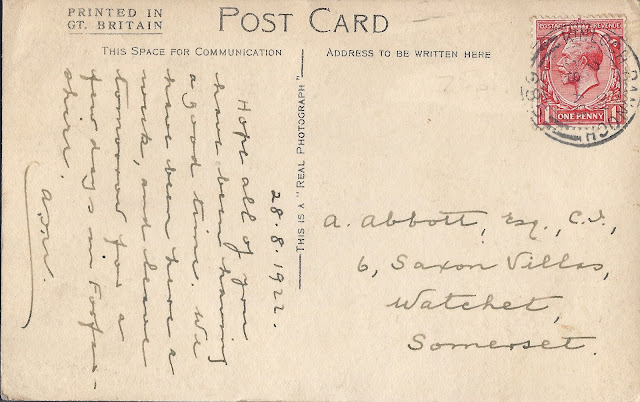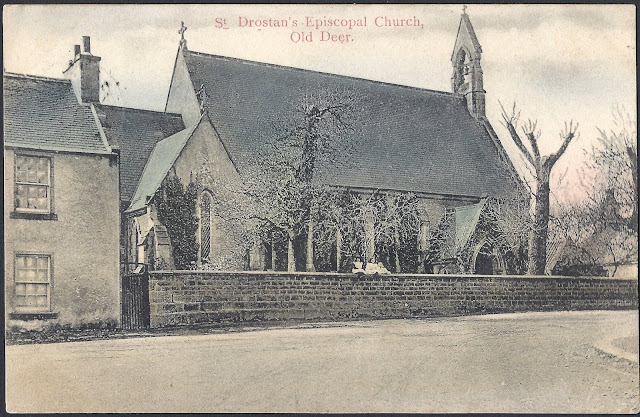 |
| Dunalastair Hotel Kinloch Rannoch in the late 1910s |
Last Sunday I returned from a splendid two week sunlit holiday in Scotland. Glad to have escaped the short but brutal heatwave in the Netherlands, the Highlands looked very inviting in the sunny summer gloom, as did the coasts. You were barely able to discern the Scottish shores from its warmer Mediterranean equivalents. The second week of my stay in this welcoming country I resided on the southern shores of Loch Rannoch. This place surrounded me with a similar feeling of mystique as the oracle city of Delphi in Greece: it felt as if the whole Highland landmass revolved around Loch Rannoch and its forests. Rannoch proved to be no easy place to reach. Until the late 18th century merchants and a rare solitary traveller would have to cross the tumultuous Tummel river at Killiecrankie by a ramshackle ferry. From there you would have to find you way westwards for over 26 km by using (I imagine) little trodden paths. You covered the whole length of Loch Tummel before you would have reached the hamlet of Kinloch Rannoch. Today, a motorized vehicle makes the journey in about an hour from Pitlochry. If you would mark this small town on a Scottish map, you notice that the distance to the sea either west- or eastwards is of the same length. Moreover, when 2 persons would travel to the north or to the south at the same speed in a straight line, I think both would arrive at about the same time with only minutes apart at resp. the northern coast and the southern border. I think this wholly justifies my feeling of Loch Rannoch being the metaphorical 'craddle' of Scotland and so I hereby unofficially declare its lake and silent forests as the navel or epicenter of Caledonia. I would not put its mythical center in the dark 100m deep lake, but rather on its southern shore where a very special forest veils the gently sloping hills below: the little known Black Forest of Rannoch
Black forest of Rannoch
In folklore this forest is called the Black Forest. Why ancient people decided to give it this name could be due to two reasons: the Scottish Pines (out of which this forest primarily consists) look quite dark from the opposite side of the Loch: hence the adjective 'Black'. A more poetical origin could be found in the belief that people of old found the forest to be very old itself, ancient even and therefore a bit scary, if not terrifying. Of course both explanations ring true. The forest is rather magnificent even though it's only a small remainder of the enormous Pine forests which once inhabited large patches of Scotland. Although small and very rare (the forest is said to be over 6000 years old) I've seen only two other tourists gazing in amazement at the monumental pinewood during my stay there. I could only think of the big advantages this (until now) quite hidden pearl of ancient woodland has. I was able to stroll at a leisurely pace under its formidable trees without seeing a single soul and without hearing anything. At some moments the silence of forest made me realize how deafening the world of today would be for the people who first inhabited Loch Rannoch, or literally everyone born before the Industrial Revolution. Throughout the day you would hear small forest birds peeping or squeaking, but definitely not singing as if the tremendous age of the forest forbade all animals to transcend the forest with their worldly sounds. In some strange eerie (even Kafkaesque) way you feel trapped, even though the open pine canopy allows the blue sky to be visible resulting in very stark contrasts. Still, when you walk there all on your own over the brown hollow sounding paths which are shaped by endless needles and gnarled roots, you are not only dwarfed by the Titanean trees but you also experience an utter state of awe. I've included only one picture of the forest, since it's simply impossible to describe the feeling I experienced there under the rocky pines and thick undergrowth of logs, ferns, mosses and berries.
 |
| The majestic Black Forest of Rannoch, July 2019 |
Kinloch Rannoch
At the eastern end of Loch Rannoch the now small village of Kinloch Rannoch lies. The village does not comprise more than a bridge, a couple of older houses along the main road and a 1970s housing estate, although there is a country store for basic groceries and one of the oldest and most luxurious hotels in Scotland: the Dunalastair (see photo postcard above). The original inn was established in 1788 and is said to have been built by Jacobite soldiers after their defeat at Culloden. I should add that the whole village of Kinloch Rannoch exists only because Jacobite soldiers sought a place - or should I say refuge - for a modest living. In the 1860s the Dunalastair estate belonged to a member of the Macdonald clan, which built the current hotel and renamed it the Macdonald Arms Hotel.
 |
| Address side of the Dunalastair Hotel photo postcard postmarked with a 685 Kinloch Rannoch CDS 'double arc' on 1d George V ~ 28-8-1922 |
The Dunalastair Hotel postcard above was sent on the 28th of August 1922 when the hotel was already quite renowned. The sender writes that he stayed in the hotel for one week and the he would leave the next day for Forfarshire (current Angus). The postcard was sent to Watchet, Somerset.
 |
| George V 1d tied by a 685 Kinloch Rannoch CDS |
When I stayed at Kinloch this summer the post office (counter in the country shop) only opened in the morning between 8:30-11:30. It was closed on Saturday and I was amazed I couldn't even buy some stamps to frank my postcards with because the stamps were put in a vault after the post office closed at 11:30 a.m.... Apparently the UK has some severe restrictions on who may sell postage stamps. Although the postcards did eventually arrive, the Edwardian and Georgian opening times of the Kinloch Rannoch post office would have saved me a 15 minute drive the next morning. The office opened in 1825 and until 1827 fell within the post town district of Aberfeldy. Thereafter Pitlochry became Rannoch's post town. In 1896 the post office was granted the numeral 685 and in 1905 it became a sub-office of Pitlochry.
 |
| Kinloch Rannoch seen from the east with the Dunalastair Hotel just over the first bridge on the right. The Black Forest of Rannoch is barely discernible over the flat headland protruding into the loch. © Jānis Šmēdiņš |
 |
| Proof that the Kinloch Rannoch post office was open after 11:30 am (in 1905) |









No comments:
Post a Comment